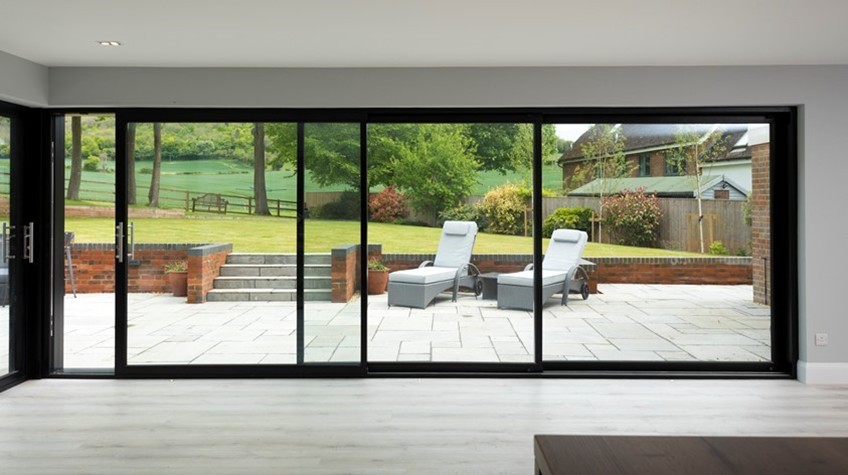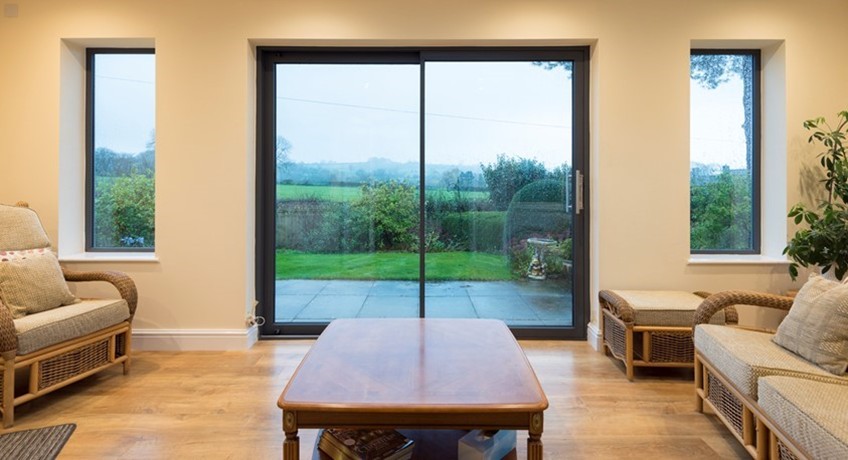When looking to purchase new external sliding doors for a home renovation or DIY upgrade, there are many factors to consider before making a decision. For example, you may be asking: which material of frames should you buy? What’s the safest track system? Or what are the different types of sliding patio doors?
Answering these questions about your sliding doors will help you find the best fit for your property. This helpful guide includes everything you need to know about sliding door track systems and explores the options when it comes to choosing your ideal patio slider. We also highlight the advanced design features of the latest Origin Sliding Doors, which offer unbeatable performance and elegance.
In this guide:
Learn about the key components and design innovations that make sliding door tracks important.
Explore how concealed tracks enhance safety, aesthetics while reducing maintenance.
Understand that sliding door tracks are dependent on the configuration of door you select.
Get practical answers on cleaning, maintenance, and key considerations.
Sliding Door Tracks Explained: Why Do They Matter?
Sliding door opening and closing mechanisms may appear simple, especially when compared to folding doors. However, innovative door carriages and trollies involve complex designs. These enhance the doors operation, performance and functionality.
What are the key components of the aluminium sliding door track?
- Running Gear: the carriage system that allows the doors to slide smoothly with even weight distribution.
- Track: the aluminium channel that the running gear sits in. There is one at the top and bottom of the sliding door system and they’re essential for smooth operation.
- Weighted Bearings: these make up part of the running gear and ensure your doors remain in position when open or closed.
At Origin’s Buckinghamshire facility, all components are produced to an exceptionally high standard (with an ISO 9001 Quality accreditation). Innovative designs, premium-grade aluminium and high-spec materials ensure seamless operation, visual appeal, safety and durability. The track of Origin Sliding Doors can be recessed into the ground to create a more seamless transition between indoors and out.

What Are Concealed Track Systems and What are the Benefits?
Some sliding doors, such as Origin’s OS-29+, feature a concealed track. This design makes them safer for fingers and toes, and they prevent items getting caught as easily. Concealed tracks also help to minimise debris getting in the track.
Sliding doors with concealed tracks are beneficial for a number of reasons:
- Reduced chance of injuries and items getting caught in the track.
- Reduced maintenance with less possibility for debris getting inside the track.
- Improved aesthetics.
When investing in the right sliding door for your home, it’s essential to get every detail right, including choosing a manufacturer that offers high quality joinery and engineered tracks that that balance design, functionality and safety. This means that your doors operate seamlessly and look elegant for decades to come. Explore the wide range of Sliding Doors by Origin.

Which Aluminium Sliding Door Track Should You Expect?
Find your local installer today to bring your vision to life
Origin Sliding Doors – such as the OS-29+ - are available with robust concealed track systems for a stunning aesthetic. Even if your track is not concealed, all Origin Sliding Doors can be recessed into the floor for a smooth transition into the outside space.
Two types of track are available (double track or triple track). The configuration of your door will determine which your door is supplied with.
What are the types of sliding door track systems?
- Double Track: used for sliding doors with two sashes stacking behind one another. This option is the narrowest from front to back, but as it’s only for two door configurations, it covers a limited aperture.
- Triple Track: used for sliding doors with three or more sashes sitting behind one another. This option has a deeper track, but covers larger apertures which allows for wider openings.
How Does a Double Track Differ from a Triple Track?
Simply put, the number of tracks correlates to the number of door sashes that can stack behind one another when open. A double track will accommodate two sashes, meanwhile, a triple track accommodates three. The wider triple track sliding doors will take up more space in your home as it’s deeper from front to back (or inside to outside), but is suitable for wider patio door openings..
The latest Origin OS-29+ Sliding Patio Door offers seamless design, innate luxury, outstanding security and market-leading thermal efficiency. The slimline aluminium slider offers U-Values as low as 0.78W/m2K.
Compare the dimensions of double vs triple tracks for the OS-29+ Slider or the OS-44/77 systems.
| OS-29+ | OS-44/OS-77 | |
|---|---|---|
Double Track Depth | 167mm | 143mm |
Triple Track Depth | 249mm | 213mm |

Can you have sliding doors on a single track?
Single track sliding doors are usually limited to indoor applications such as room dividers or a pocket door, a wardrobe or barn door because they can only consist of one sash and can’t be easily secured for external use. Origin do not supply single track or single sash sliding doors.
Your desired configuration will decide the track type that you need. For instance, if you require more door sashes (common with larger apertures), you will likely have a triple track. Meanwhile, a double track may be sufficient for smaller doors or configurations requiring only two sashes. Your local installer will be able to talk you through the available configuration options.

Download the latest Sliding Door brochure
Get in touch today
If you're interested in getting a bespoke new patio door, or want to learn more about your options, get in touch with your local installer. They will be happy to provide you with advice and guidance on what will work best for your property.
The next steps involve an on-site survey, taking measurements and other factors into account. The installer can order the door directly from us and will source your desired sliding door glazing.
Frequently asked questions
How do you clean sliding door tracks?
Many people use an old toothbrush (or brush that won’t scratch the profile) to dislodge any dirt, then hoover out any debris. It is recommended that you clean your sliding door tracks at least once a week to maintain optimal functionality. Read about sliding door maintenance for more information.
How do you keep your tracks and slider in good condition?
It is important to keep your sliding door tracks in good condition by regularly cleaning them and ensuring they are well lubricated. Avoid slamming the doors them shut or opening too vigorously. You can use a silicone spray to keep the door gear lubricated. Try and avoid any loose debris getting stuck in the tracks. If it does, vacuum it out immediately or it could damage the sliding mechanism or cause the door to jam.
How do you fix broken sliding door runners?
If your sliding door isn’t operating perfectly, even with proper maintenance (detailed above), it’s always best you get in touch with your installer so they can provide the best advice and avoid any further damage.
What do you need to consider when it comes to sliding door tracks?
Your installer will discuss all the options with you including the possibility of recessing the track into the floor, drainage considerations and the available configurations.






